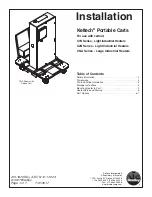
California Ladder Regulations, Safety & Operation
A. In construction, except where either permanent or temporary stairways or suitable ramps or runways are provided, ladders shall be used to give safe
access to all elevations. 1675(a)
B. General requirements for portable ladders are as follows:
1. Portable ladders in construction shall comply with T8 CCR 3276. 1675(b)
2. Design and construction of portable ladders shall comply with T8 CCR 3276(c).
3. Extension ladders shall comply with 3276.
4. All portable metal ladders and wood ladders shall comply with 3276.
5. Portable reinforced plastic ladders shall comply with 3276.
C. Portable ladders are generally designed for one-person use to meet the requirements of the person, the task, and the environment. When selecting a
ladder for use, consider the ladder length, height, the working load, the duty rating, worker position, and how often the ladder is used. 3276(d)(1)(B)
D. Double-cleat ladders are required for two-way traffic or when 25 or more employees are using a ladder. Double-cleat ladders shall not exceed 24 feet in
length. 1629(c)
E. Maximum lengths of portable ladders shall not exceed the following: 3276(e)(16)(D)
Ladder Type
Maximum Length (Feet)
Step Ladder
20
Two-section extension ladder (wood)
60
Two-section extension ladder (metal)
48
Three-section extension ladder (metal)
60
Two-section extension ladder (reinforced plastic)
72
Painter’s step ladder
12
Cleat ladder
30
Single ladder
30
F. Minimum overlap in two section portable extension ladders shall not be less than the following: 3276(e)(16)(E)
Ladder Size (Feet)
Minimum Overlap (Inches)
Up to and including 32
36
Over 32, up to and including 36
46
Over 36, up to and including 48
58
Over 48, up to and including 60
70
G. Portable ladders shall be used according to the following duty classifications: 3276(d)(2)
Duty Rating
Ladder Type
Working Load (Pounds)
Special Duty
IAA
375
Extra Heavy0Duty
IA
300
Heavy-Duty
I
250
Medium-Duty
II
225
Light-Duty
III
200
H. All portable ladders used in outdoor advertising structures shall be at least Type I, Type IA or Type IAA as designed and constructed in accordance with T8
CCR 3276. 3413(a)
I. Inspection and maintenance requirements for portable ladders are below:
1. Ladders shall be maintained in good condition at all times. 3276(e)(1)
2. Metal ladders shall not be exposed to acid or alkali materials that are capable of corroding the ladder and reducing the ladder’s strength, unless
recommended otherwise. 3276(e)(1)
3. Ladders shall be inspected by a Qualified Person for visible defects frequently and after any occurrence that could affect their safe use. 3276(e)(2)
4. Remove ladders that have developed defects such as broken or missing steps, rungs, cleats, safety feet, side rails, or other defects from service,
and tag or mark them with “Dangerous, Do Not Use”. 3276(e)(3)
5. All ladders shall be free of oil, grease, or slippery materials. Wood ladders shall not be painted with other than a transparent material. . 3276(e)
(4),(5)
J. Prohibited uses of portable ladders are given below:
1. Ladders shall not be used as a brace, skid, guy or gin pole, gang-way, or for uses they were not intended, unless recommended by the
manufacturer. 3276(e)(16)
2. Do not place planks on the top step or top cap. 3276(e)(16)(B)
3. Step ladders shall not be used as single ladders or in the partially closed position. 3276(e)(16)(C)
K. To safely use portable ladders employees must also follow the requirements noted below:
1. All portable ladders used for window washing shall be equipped with nonslip devices. Middle and top sections shall not be used as bottom
sections unless equipped with nonslip bases. 3287(b)(2)
2. Portable ladders shall not be overloaded when used. 3276(e)(6)
3. The base of ladders shall be placed on a secure and level footing. Ladders shall not be placed on unstable bases. 3276(e)(7)
4. Ladders shall not be used on ice, snow or slippery surfaces unless slippage is prevented. 3276(e)(7)
5. The top of non self supporting ladder shall be placed with two rails supported equally, unless a single support attachment is provided and used.
3276(e)(8)
6. Non self supporting ladders shall, where possible, be used so that the horizontal distance from the top support to the foot of the ladder is one-
quarter of the working length of the ladder. 3276(e)(9)
7. The ladder shall be so placed as to prevent slipping, or it shall be tied, blocked, held, or otherwise secured to prevent slipping. 3276(e)(9)
8. Ladders shall not be used in a horizontal position as platforms, runways, or scaffolds unless designed for such use. 3276(e)(9)
9. When two or more separate ladders are used to reach an elevated work area, the ladders shall be offset with a platform or landing between the
ladders (see exceptions). 3276(e)(10)
10. Extend ladder side rails to at least 3 ft. above the landing unless handholds are provided. 1629(c)(3), 3276(e)(11)
11. Do not tie ladders together to provide longer sections unless the ladders are designed for such use and equipped with the necessary hardware


































